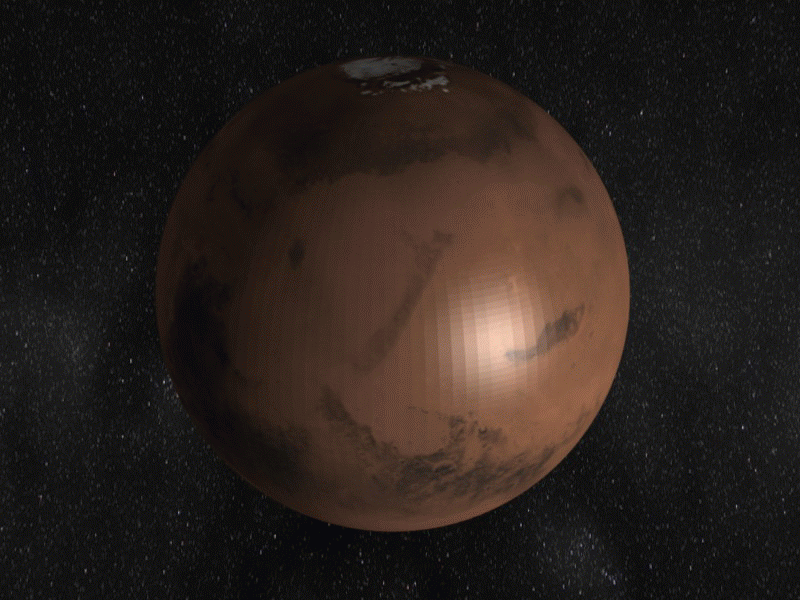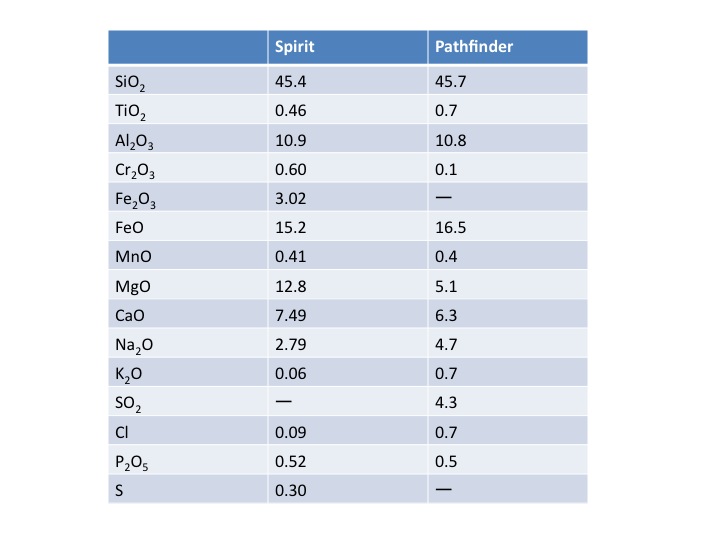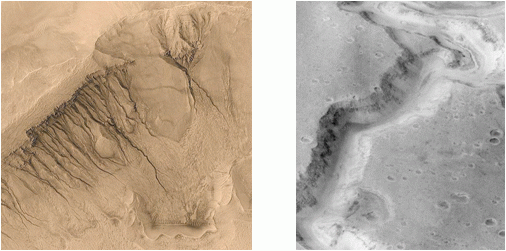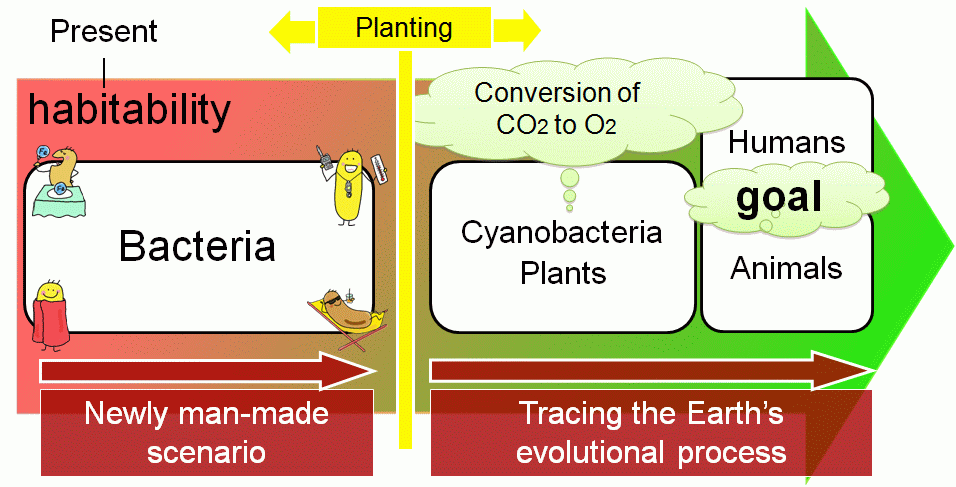Team:Tokyo Tech/Project
From 2009.igem.org
| Main | Team | Terraforming | Experiments | [http://partsregistry.org/cgi/partsdb/pgroup.cgi?pgroup=iGEM2009&group=Tokyo_Tech Parts] | Safety |
Contents |
What is Terra Forming?
“When will we humans be able to travel freely in space and inhabit another planet in our solar system?”
This is a fundamental question, or a dream, we all have asked once before in our childhood or later. This year, Tokyo Tech team provides you with a new combination of “synthetic biology” and “terra forming” which will contribute not only to open the new doors of recent Mars missions but also to greatly stimulate your intellectual curiosity about future space technologies.
Terra Forming is a part of planetary engineering, specifically directed at deliberately modifying extraterrestrial planetary environment conditions such as atmosphere, temperature, pressure, surface topography or biosphere to be similar to those of Earth so that the targeted planet will be one day sustainably habitable for human beings and Earth-based life forms. For example, if the surface environment of a particular planet is too dry for life to live and grow although liquid water is critical, terra-forming technologies play a role to realize an appropriate environmental condition with sufficient water in liquid form to support life.
This academic discipline was firstly proposed in a scientific article titled “The Planet Venus (Carl Sagan, 1961, Science)” and then, the concept of “Mars terra forming” was suggested in other articles such as “Planetary Engineering on Mars (Carl Sagan, 1973, ICARUS) and “Terra Forming Mars (Christopher McKay, 1991, Journal of the British Interplanetary Society).” Though some exciting hypothetical processes to terra-form Mars have been proposed by several scientists so far, any of those plans haven’t been carried out yet practically because they generally require big budgets and huge amount of time. However, there are still two positive aspects of terra forming. Firstly, with today’s advanced technologies, we could make current Martian environment suitable for life more effectively and efficiently. Secondly, such an experiment on a planetary scale would allow us to understand more the planet Earth by examining how its ecological systems grow and evolve with different approaches. In that sense, terra-forming technologies are in need to keep being developed constantly.
The Most Earth-Like Planet “Mars”
This year, Tokyo Tech team has particularly focused on Mars as the most feasible planet in our solar system to realize terra forming though it is a cold, dry and desert-like world with a thin atmosphere now. Why? The reason is simple. It’s because Mars is the most Earth-like planet in our solar system.
According to a scientific article titled “Bringing Life to Mars (Christopher McKay, 1999, Scientific American)”, it is said that four billions ago, Mars was a warm and planet, possibly teeming with life. For instance, more than 30 years ago, the Mariner and Viking (space probes developed by National Aeronautics and Space Administration; NASA) found that some chemical elements needed for life were present on Martian surface (Chemical Composition). Recently, the Mars Global Surveyor, another space probe created by NASA, has returned images of canyons, flood valleys and fan-shaped areas suggesting that liquid water, the quintessential ingredient for life, once flowed on the planet’s surface (Water on Mars). Now, it is considered that water exists in solid form in the planet’s polar caps as well as carbon dioxide. Additionally, many of the key physical properties of Mars are remarkably similar to those of Earth such as the length of day (an important factor for plant life’s photosynthesis) and the axis tilt (an important factor for season cycle). Since Mars is farther from the Sun compared with Earth, it is true that there exist some unalterable differences between the two planets. For instance, a Martian year is almost twice the length of an Earth year. Martian gravity is about the one-third that of Earth’s which would be probably too weak to hold as thick atmosphere as Earth’s. Martian atmosphere composition primarily consists of carbon dioxide and a little of nitrogen while Earth’s of nitrogen and oxygen. Moreover, as previously mentioned, Mars is currently too cold and too dry. However, microbes and plants should be likely to easily adjust to those differences interrelated to each other with appropriate and effective human intervention and biological changes. Or at least, it can be said that Mars is the most Earth-like planet in our solar system compared with any other planets having been considered as potential sites for life, such as Venus having excessively hot temperatures or Titan being too far away from the Sun, which means Mars is the most feasible planet to realize terra forming. This is the reason why we have focused specifically on Mars as a terra-forming objective.
Long term approach for Terraforming
In long term,
- 1. Start Point of Terra Forming
- 2. Microorganisms I (for adaptation)
- 3. Microorganisms II (for habitat manipulation)
- 4. Cyanobacteria / Plants
- 5. Animals
- 6. Human Beings
Short term approach for Terraforming
In short term or in those steps, our approach is shown below.
- Heat Energy Injection
- Heat Energy Production
- Atmosphere Generation
- Organic Matters Accumulation
- Water Accumulation
Approaches
Actually we have four ideas to terraform the Mars.
 Iron-oxidizing bacteria |
 Consortium |
 Antifreeze protein |
 Blackened E.coli |
 Cph |
Related works
- Sagan, C. The Planet Venus: Recent observations shed light on the atmosphere, surface, and possible biology of the nearest planet. Science (New York), 1961, 133, 849
- McKay, C. Terraforming Mars, Journal of the British Interplanetary Society, 1982, 35, 427-433
- McKay, C. Bringing life to Mars, Scientific American--The Future of Space Exploration, 1999, 1, 20-23
- Toulmin, P., Rose, H., Christian, R., Baird, A., Evans, P., Clark, B., Keil, K. & Kelliher, W. Geochemical and mineralogical interpretation of the Viking inorganic chemical results(for Martian surface materials) Journal of Geophysical Research, 1977, 82, 4625-4634
- McSween et al. 2006
 "
"





